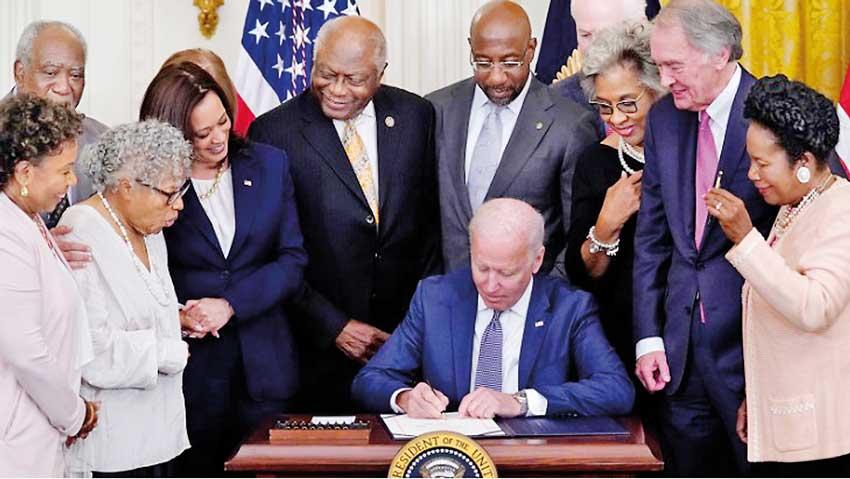Reply To:
Name - Reply Comment

Biden signs Juneteenth national holiday act
 Colombo, June 18: The United States marks June 19 every year as the day on which Abraham Lincoln ended slavery. On June 17 this year, President Biden made June 19, popularly known as “Juneteenth” a federal holiday.
Colombo, June 18: The United States marks June 19 every year as the day on which Abraham Lincoln ended slavery. On June 17 this year, President Biden made June 19, popularly known as “Juneteenth” a federal holiday.
Signing the legislation on Thursday to make ‘Juneteenth’ a federal holiday, Biden said: “All Americans can feel the power of this day, and learn from our history.” The Senate had rushed the measure through with no debate after clearing away a longstanding Republican objection, and the House of Representatives approved it by a vote of 415 to 14, with all of the opposition coming from the Republicans, New York Times reported.
But the question that is periodically asked is: Did Lincoln really end slavery or discrimination? Did he even mean to end it unconditionally? And are the conditions of the Blacks satisfactory now, more than a century later?
Indeed, Jim Crow laws were technically off the books, but the Blacks continued to be disadvantages in multiple ways
Historical Background
It was on June 19, 1865 that Maj. Gen. Gordon Granger in Galveston, Texas, issued General Order No. 3, which announced that in accordance with President Lincoln’s Emancipation Proclamation, “all slaves are free.” Months later, the 13th Amendment was ratified, abolishing slavery in the final four border states that had not been subjected to President Lincoln’s order.
In his 2004 book The End of Slavery in America, Allen C. Guelzo says that Lincoln was not really motivated by a commitment to end slavery. In his letter to Horace Greeley, Lincoln had written: “My paramount object in this struggle is to save the Union, and it is not either to save or destroy slavery. If I could save the Union without freeing any slave, I would do it, and if I could save it by freeing all the slaves, I would do it; and if I could save it by freeing some and leaving others alone I would also do that.”
According to Richard Hofstadter, the document Lincoln issued only freed slaves where the federal government had no power. It did not apply to slaves in the loyal slave states or in those parts of the Confederacy under Union control. And the Constitution had left the issue of slavery to the States.
Lincoln’s critics say that he was no friend of the Blacks; he did not want to risk the political fallout that would result from freeing slaves and that he was forced by circumstances to free them to save the USA from disintegration. Be that as it may, the undeniable fact is that Lincoln had taken the first and the most important constitutional step to free the slaves.
Jim Crow laws
However, despite the “Emancipation” Proclamation” the States continued to have what were called “Jim Crow laws”. According to the website history.com, Jim Crow laws were a collection of State and local bodies’ statutes that legalized racial segregation. These laws existed from the post-Civil War era until 1968.
“They were meant to marginalize African Americans by denying them the right to vote, hold jobs, get an education or other opportunities. Those who attempted to defy Jim Crow laws often faced arrest, fines, jail sentences, violence and death,” the website said.
“Black Codes” existed throughout the American South as a legal way to put Blacks into “indentured servitude, to take voting rights away, to control where they lived and how they traveled and to seize children for labor purposes.”
The Black Codes operated in conjunction with labor camps for the incarcerated, where prisoners were treated as slaves. Black offenders typically received longer sentences than their White equals. And even more sadly, because of the grueling work assigned to them, the Blacks often did not live out their entire sentence, the website says.
Violence was routinely unleashed on the Blacks. Black schools were vandalised. Bands of Whites attacked, tortured and lynched Blacks. Families were forced to vacate their lands across the Southern States. Ku Klux Klan, was born in 1865 in Pulaski, Tennessee, as a private club of Confederate soldiers. The KKK spearheaded anti-Black violence throughout the South.
Anti-Black violence resulted in Blacks quitting the rural areas and migrating to the cities. But here again, they came up against demands to curb them. “Public parks were forbidden for African Americans to enter, and theaters and restaurants were segregated. Segregated waiting rooms in bus and train stations were required, as well as water fountains, restrooms, building entrances, elevators, cemeteries, even amusement-park cashier windows. Laws forbade African Americans from living in White neighborhoods.”
Some States required separate textbooks for Black and White students. New Orleans even mandated the segregation of prostitutes according to race! Marriage and cohabitation between white and Black people was strictly forbidden in most Southern states.
Black Resistance
In response to the Jim Crow laws, individual Blacks began to offer resistance in the late 1880s. A Black lady, Ida B.Wells, toured the Southern States advocating the arming of Blacks. She investigated lynching and wrote about them. When a mob destroyed her newspaper and threatened her with death, she moved to the North, where she continued her work. A former slave, Isaiah Montgomery, advocated Black separatism. He created the “Blacks only” town in Mound Bayou, Mississippi, in 1887. Mound Bayou still exists with a 100% population.
In the years following the 1914-18 First World War I, lynching was common, and that triggered Black resistance and led to race riots. There were 25 race riots across the US in 1919, history.com says.
Race riots in the South led to educated Blacks migrating to the Northern States, which were more tolerant, though the North too had segregation. Some states required Black people to own property before they could vote, schools and neighborhoods were segregated, and businesses displayed “Whites Only” signs.
The Great Depression of 1929, only deepened racial feelings. There was a spurt in lynching. Even Black soldiers returning home from World War II battles met with segregation and violence. Blacks often found it difficult or impossible to obtain mortgages for homes in certain “red-lined” (Whites Only) neighborhoods.
Civil Rights Movement
However, the post-World War II era saw an increase in civil rights activities among the Blacks (since known as the “African-American community), with a focus on ensuring that Blacks were able to vote. This ushered in the Civil Rights Movement, resulting in the removal of Jim Crow laws.
“In 1948 President Harry Truman ordered integration in the military, and in 1954, the Supreme Court ruled in Brown v. Board of Education that educational segregation was unconstitutional, bringing to an end the era of “separate-but-equal” education. In 1964, President Lyndon B. Johnson signed the Civil Rights Act, which legally ended the segregation that had been institutionalized by Jim Crow laws. And in 1965, the Voting Rights Act halted efforts to keep minorities from voting. The Fair Housing Act of 1968, which ended discrimination in renting and selling homes, followed.”
Indeed, Jim Crow laws were technically off the books, but the Blacks continued to be disadvantages in multiple ways. Typically, they were the ones who would be subjected to police brutality as was seen in the case of George Floyd recently.
The crushing to death of Floyd led to uncontrollable violence. The people’s revulsion for racism and White supremacism led to the multi-racial “Black Lives Matter” movement. Racism no longer enjoys political sanction in the US, though it will take long to eradicate it.